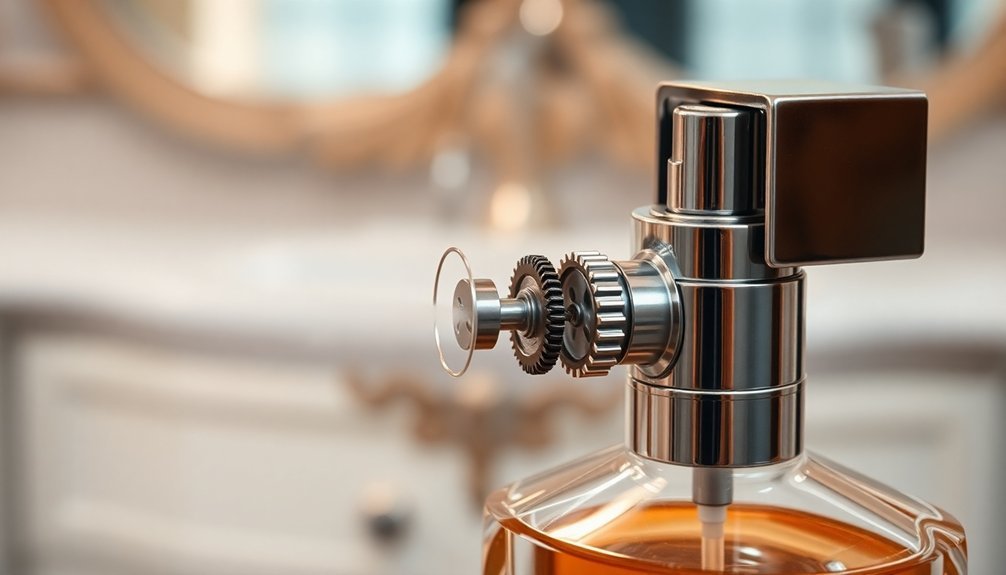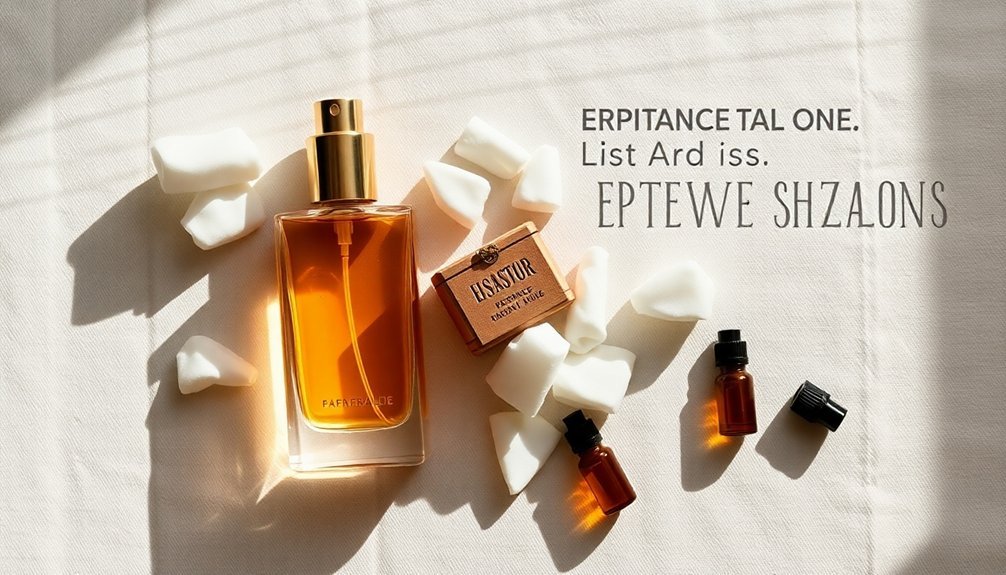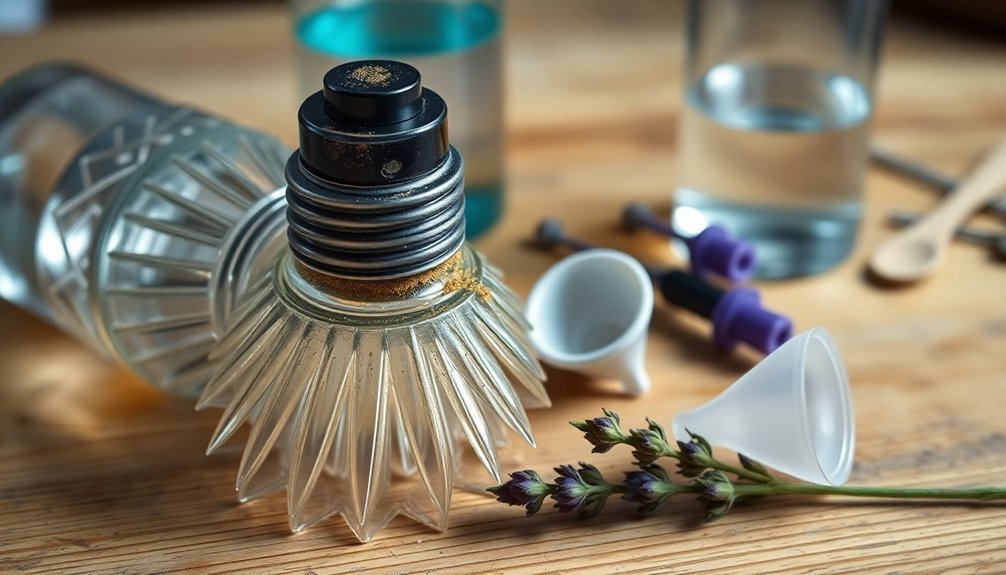Your perfume spray bottle won't work properly when dried residue clogs the nozzle, air bubbles disrupt the flow, or physical damage affects the mechanism. You'll notice signs like inconsistent spray patterns, difficulty pressing the pump, or no spray at all. Quick fixes include cleaning with rubbing alcohol, using a fine needle to clear blockages, or gently shaking to restore pressure. Understanding your spray bottle's mechanics can help you solve these common issues.
Understanding Your Perfume Spray Bottle Mechanism

A perfume spray bottle is more complex than it appears at first glance. When you press the pump, you're activating a sophisticated mechanism that converts your liquid fragrance into a fine mist. The process relies on a carefully designed system of components working together seamlessly.
Your perfume bottle's spray mechanism consists of a pump assembly, plastic tube, and specialized nozzle. When you press down on the pump, it creates pressure that forces the fragrance up through the tube and out through the nozzle. Fragrance performance can deteriorate due to increased air exposure when the mechanism malfunctions.
The nozzle's design is essential as it atomizes the liquid into the perfect spray pattern. Understanding these basics can help you identify what's wrong when your spray bottle isn't working correctly, whether it's an airlock issue, a clogged nozzle, or a faulty pump mechanism.
Common Reasons for Spray Bottle Malfunctions
If your perfume spray bottle isn't working properly, you'll likely encounter one of two main problems: a clogged nozzle or an airlock issue.
When dried perfume residue blocks the nozzle, you'll notice either no spray or large droplets instead of a fine mist. Regular atomizer maintenance can help prevent these blockages and ensure proper functionality.
Air pressure problems can also prevent proper spraying, which often happens when air pockets form in the pump system due to improper storage or excessive shaking.
Nozzle Blockages Halt Spraying
The frustrating experience of a malfunctioning perfume spray often stems from nozzle blockages. When you notice large droplets or no spray at all, dried perfume residue and trapped particles are likely clogging your bottle's tiny opening.
You'll sometimes hear a squeaking sound or feel increased resistance when pressing the nozzle, signaling it's time for maintenance. Proper routine care and inspection will help prevent these issues from developing.
You can address these blockages using simple methods at home. Try inserting a fine needle into the nozzle to clear the obstruction, or use hot water to dissolve dried residue.
For stubborn clogs, rubbing alcohol can help clean both the nozzle and pump mechanism. If these solutions don't work, you might need to disassemble the atomizer for a thorough cleaning.
Remember to dry the components completely to prevent future blockages.
Air Pressure System Failures
Properly functioning spray bottles rely heavily on their internal air pressure systems, which can fail for various reasons. When air pockets form in the tube connecting the nozzle to the bottle, they'll disrupt your perfume's flow and reduce spraying efficiency. You'll notice these issues through inconsistent or weak spray patterns.
| Issue | Cause | Solution |
|---|---|---|
| Air Pockets | Bubble formation in tube | Gently shake or invert bottle |
| Low Pressure | Insufficient perfume levels | Check levels and refill |
| Pump Problems | Mechanical malfunction | Recalibrate by pumping |
You can fix most pressure-related problems by inverting the bottle and pumping the nozzle several times. If you're still experiencing issues, check that your nozzle aligns properly with the spray tube and verify you're maintaining proper storage practices to prevent future pressure failures.
Essential Tools for Spray Bottle Maintenance

Professional perfume bottle maintenance requires specific tools and equipment to secure ideal performance and longevity.
You'll need crimping tools to secure bottle caps effectively, whether you're using hand-held devices for small operations or manual collar presses for crimp-less pumps.
For larger operations, you'll find tabletop manual crimping machines invaluable, as they handle various bottle sizes while maintaining consistent results.
Don't forget essential measuring tools like disposable pipettes, which come in different sizes for precise liquid transfers and help prevent spills during formulation.
When spray mechanisms fail, you'll need access to replacement parts.
While finding exact nozzle matches can be challenging, it's worth contacting manufacturers directly to guarantee compatibility.
Regular maintenance with these tools will extend your perfume bottle's lifespan and preserve its functionality.
Step-by-Step Spray Nozzle Cleaning Guide
You'll need a few basic tools before starting your perfume spray nozzle cleaning: warm water, mild soap, cotton swabs, and a small pin for stubborn clogs.
A quick cleaning method involves removing the spray mechanism from the bottle and soaking it in warm, soapy water for about 5 minutes.
After soaking, use cotton swabs to clean around the nozzle opening and rinse thoroughly with warm water.
Quick Cleaning Methods
When spray nozzles become clogged with perfume residue, a few simple cleaning methods can quickly restore their functionality.
You'll find that hot water treatment and rubbing alcohol are your best allies for quick cleaning solutions. Using a cotton swab or ball with rubbing alcohol lets you effectively clean both the nozzle and internal areas without causing damage.
- Soak the nozzle in hot water for a few minutes to dissolve hardened particles, then gently tap out any loosened debris.
- Apply rubbing alcohol to a cotton ball and carefully clean the nozzle and surrounding areas.
- Use a cotton swab with mild soap to reach delicate internal components, followed by a warm water rinse.
Remember to avoid harsh chemicals and sharp objects during cleaning to protect your perfume bottle's delicate spray mechanism.
Tools Needed First
A successful spray nozzle cleaning job requires just five essential tools before you begin.
You'll need a thin needle or pin to clear blockages, cotton balls for applying cleaning solutions, and rubbing alcohol to break down stubborn residue. Hot water is vital for soaking and dissolving dried perfume buildup.
Finally, keep a pair of tweezers handy for handling small parts.
While there are other tools you might find useful, these five basics will help you tackle most spray nozzle problems. They're especially effective for routine maintenance and common blockages.
If you're dealing with a more complex issue that requires disassembly, you may want to add pliers and replacement O-rings to your toolkit, but start with these essentials first.
Proper Storage and Handling Techniques

Proper storage and handling can markedly extend your perfume's lifespan and maintain its original scent profile.
You'll want to keep your fragrance in a cool, dark place around 60°F, away from direct sunlight and humidity. The original bottle and packaging provide the best protection against environmental factors that can degrade your perfume.
- Don't shake your perfume bottle excessively, as this introduces air and speeds up oxidation.
- Keep the bottle sealed when not in use to minimize oxygen exposure.
- Check the spray nozzle regularly for clogs or dried residue.
When handling your perfume, avoid frequent opening and closing of the bottle.
If you notice any discoloration or changes in scent, it's likely time to address storage conditions or consider replacing the fragrance.
Signs Your Spray Bottle Needs Repair
Identifying spray bottle problems early can prevent permanent damage to your favorite fragrances. Watch for telltale signs like a weak or nonexistent spray, large droplets instead of a fine mist, or squeaky sounds when you press the nozzle. These typically indicate clogging issues.
If you notice leaks around the nozzle, inconsistent spray patterns, or visible air bubbles, you're likely dealing with pressure problems.
Physical damage signs include cracked nozzles, bent dip tubes, or loose components. Pay attention to how the actuator feels – if it's harder to press than usual, something's wrong.
For collectible bottles, rare fragrances, or complex mechanical issues, don't attempt repairs yourself. Seek professional help, especially when dealing with manufacturer-specific designs or when specialized tools are needed.
DIY Fixes for Common Spray Issues

When your perfume spray bottle malfunctions, you'll find several DIY solutions that can restore its functionality without professional help.
Start by addressing nozzle clogs using a fine needle to clear blockages or soak the nozzle in hot water to dissolve residue. For pressure issues, gently shake the bottle or hold it upside down to redistribute the perfume and eliminate air pockets.
- Use rubbing alcohol on a cotton ball to clean sticky residue around the nozzle.
- Check and realign the spray mechanism by carefully twisting the nozzle.
- Tap the nozzle gently and pump several times to stimulate flow.
If these fixes don't work, you can try disassembling the nozzle with pliers for a thorough cleaning or consider transferring the perfume to a new bottle as a last resort.
Best Practices for Long-Term Spray Performance
Beyond fixing immediate spray issues, maintaining your perfume bottle's long-term performance requires strategic care and attention.
You'll get the best results by storing your bottle in a cool, dark place away from direct sunlight and heat sources. Make certain you're sealing the cap tightly after each use to prevent air exposure and oxidation.
For peak spray performance, use your perfume regularly to prevent the nozzle from clogging due to dried-out fragrance.
If you've got multiple perfumes, rotate through them to guarantee none sit unused for extended periods.
Consider the bottle size that matches your usage habits – while a 50ml bottle contains about 735 sprays, you might prefer smaller sizes if you enjoy variety.
Regular maintenance checks and proper storage will help preserve both the fragrance quality and spray mechanism functionality.
Frequently Asked Questions
Can I Transfer My Perfume to a Different Spray Bottle Safely?
Yes, you can safely transfer your perfume using a clean funnel or syringe. Make sure you've cleaned the new bottle thoroughly and check the spray mechanism after transfer to avoid pressure issues.
How Long Does an Average Perfume Spray Mechanism Typically Last?
Your perfume spray mechanism can last 3-5 years with proper care. You'll get the best longevity if you store it correctly and clean it regularly to prevent clogging from dried perfume residue.
Why Does My Perfume Spray Differently in Cold Versus Hot Weather?
Your perfume sprays differently because temperature affects evaporation rates. In hot weather, you'll get stronger projection and faster dispersion, while cold weather slows down the evaporation, creating a more subtle release.
Does the Color Change of My Perfume Affect the Spray Mechanism?
No, your perfume's color change won't affect its spray mechanism. While perfumes naturally change color over time due to oxidation, spray issues are typically caused by mechanical problems like clogged nozzles or misaligned components.
Can I Recycle Perfume Bottles With Broken Spray Mechanisms?
Yes, you can recycle perfume bottles, but you'll need to remove the broken spray mechanism first. Separate the glass bottle from plastic/metal parts and check your local recycling guidelines for specific disposal instructions.





Leave a Reply